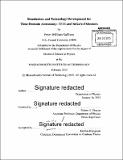Simulations and technology development for time-domain astronomy : TESS and InGaAs detectors
Author(s)
Sullivan, Peter William
DownloadFull printable version (15.75Mb)
Other Contributors
Massachusetts Institute of Technology. Department of Physics.
Advisor
Robert A. Simcoe.
Terms of use
Metadata
Show full item recordAbstract
Optical time-domain astronomy is in the midst of significant developments due to new instruments, data processing techniques, and space missions. The Kepler mission has identified thousands of exoplanet systems with the transit technique, allowing the first statistical analyses of the exoplanet population. The upcoming Transiting Exoplanet Survey Satellite (TESS) mission will complement Kepler by identifying the brightest transiting exoplanet systems on the sky. These planets will offer the most insight into their radius, mass, and composition. At approximately the same time that TESS launches, the Advanced Laser Interferometer Gravitational-Wave Observatory (aLIGO) will reach full operation, allowing the detection of gravitational waves from the mergers of compact objects out to hundreds of Mpc. Finding the electromagnetic counterparts to gravitational-wave sources, which may appear as kilonovae events, will give far greater insight into these mergers. While the Large Synoptic Survey Telescope will be a capable facility for following up triggers from gravitational-wave observatories at [lambda] < [mu]m, a wide-field infrared telescope operating at [lambda] > [mu]m would complement its capabilities. In this Thesis, I first describe a simulation of the TESS mission. The simulation predicts TESS should find hundreds of small transiting planets; those with the brightest host stars will be favorable for radial-velocity determinations of their masses and spectrophotometric measurements of their atmospheres. However, approximately half of the transit-like signals that TESS detects will turn out to be astrophysical false-positives arising from stellar eclipsing binaries. I will discuss how planets can be distinguished from eclipsing binaries using the TESS data and a ground-based follow-up campaign. Secondly, I describe the development of InGaAs detectors for near-IR imaging and photometry. These detectors are a less-expensive alternative to the HgCdTe detectors in current use, enabling wide-area IR surveys and IR observations with small telescopes to take place. Using camera hardware that I designed and constructed, I have tested InGaAs detectors as they have matured into an appropriate technology for near-IR time-domain astronomy. I will discuss their possible use for following up the TESS detections and gravitational-wave triggers.
Description
Thesis: S.M., Massachusetts Institute of Technology, Department of Physics, 2015. Cataloged from PDF version of thesis. Includes bibliographical references (pages 151-155).
Date issued
2015Department
Massachusetts Institute of Technology. Department of PhysicsPublisher
Massachusetts Institute of Technology
Keywords
Physics.